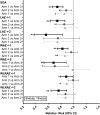Preconception nutrition intervention improved birth length and reduced stunting and wasting in newborns in South Asia: The Women First Randomized Controlled Trial
- PMID: 31995570
- PMCID: PMC6988936
- DOI: 10.1371/journal.pone.0218960
Preconception nutrition intervention improved birth length and reduced stunting and wasting in newborns in South Asia: The Women First Randomized Controlled Trial
Abstract
South Asia has >50% of the global burden of low birth weight (LBW). The objective was to determine the extent to which maternal nutrition interventions commenced before conception or in the 1st trimester improved fetal growth in this region. This was a secondary analysis of combined newborn anthropometric data for the South Asian sites (India and Pakistan) in the Women First Preconception Maternal Nutrition Trial. Participants were 972 newborn of mothers who were poor, rural, unselected on basis of nutritional status, and had been randomized to receive a daily lipid-based micronutrient supplement commencing ≥3 months prior to conception (Arm 1), in the 1st trimester (Arm 2), or not at all (Arm 3). An additional protein-energy supplement was provided if BMI <20 kg/m2 or gestational weight gain was less than guidelines. Gestational age was established in the 1st trimester and newborn anthropometry obtained <48-hours post-delivery. Mean differences at birth between Arm 1 vs. 3 were length +5.3mm and weight +89g. Effect sizes (ES) and relative risks (RR) with 95% CI for Arm 1 vs. 3 were: length-for-age Z-score (LAZ) +0.29 (0.11-0.46, p = 0.0011); weight-for-age Z-score (WAZ) +0.22 (0.07-0.37, p = 0.0043); weight-to-length-ratio-for-age Z-score (WLRAZ) +0.27 (0.06-0.48, p = 0.0133); LAZ<-2, 0.56 (0.38-0.82, p = 0.0032); WAZ <-2, 0.68 (0.53-0.88, p = 0.0028); WLRAZ <-2, 0.76 (0.64-0.89, p = 0.0011); small-for-gestational-age (SGA), 0.74 (0.66-0.83, p<0.0001); low birth weight 0.81 (0.66-1.00, p = 0.0461). For Arm 2 vs. 3, LAZ, 0.21 (0.04-0.38); WAZ <-2, 0.70 (0.53-0.92); and SGA, 0.88 (0.79-0.97) were only marginally different. ES or RR did not differ for preterm birth for either Arm 1 vs. 3 or 2 vs. 3. In conclusion, point estimates for both continuous and binary anthropometric outcomes were consistently more favorable when maternal nutrition supplements were commenced ≥3 months prior to conception indicating benefits to fetal growth of improving women's nutrition in this population.
Conflict of interest statement
The authors have declared that no competing interests exist.
Figures



References
-
- World Health Organization. World Health Statistics: monitoring health for the sustainable development goals (SDGs). Geneva: 2018.
-
- UNICEF. Stop stunting: improving child feeding, women’s nutrition and household sanitation in South Asia. Regional Conference; November 10–12; New Delhi, India: United Nations Children’s Fund; 2014. - PubMed
Publication types
MeSH terms
Substances
Grants and funding
LinkOut - more resources
Full Text Sources
Medical

